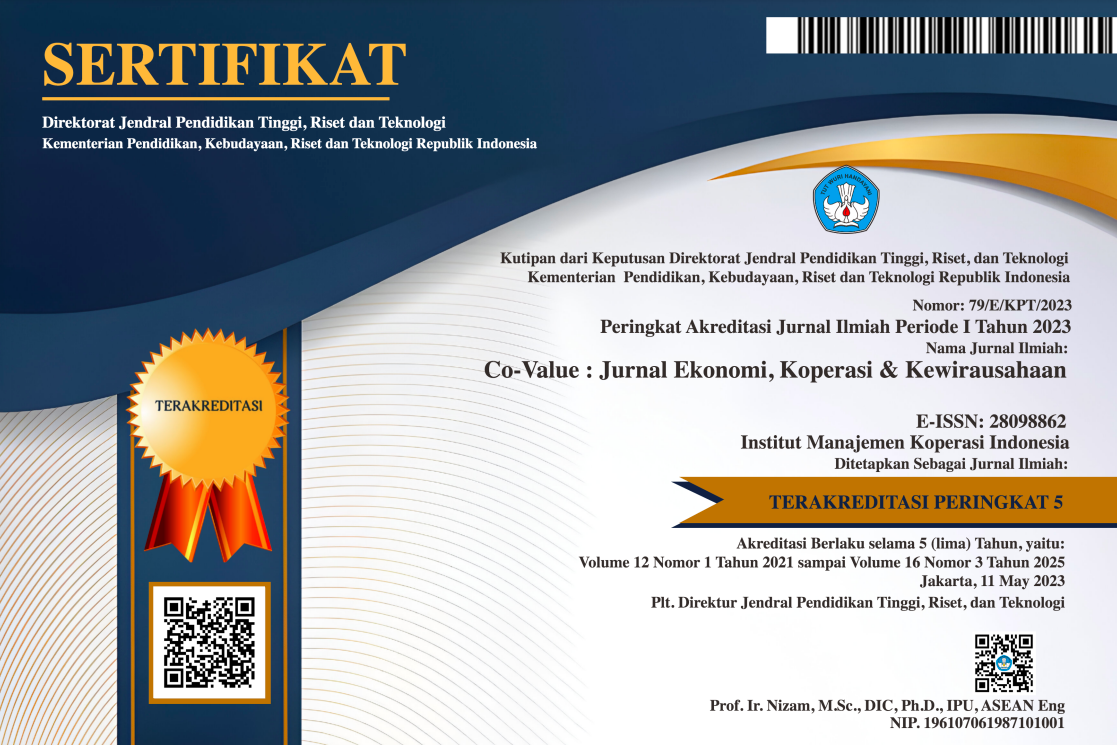A Qualitative Research on the Sustainable Fashion Business of Local Brands in Indonesia
DOI:
https://doi.org/10.59188/covalue.v15i6.4852Keywords:
Qualitative Research, Sustainable, Fashion Business, Local BrandsAbstract
The fashion industry is currently experiencing an increase due to an increase in local fashion brands which are of interest to generation Z. There are many local clothing brands in Indonesia with relatively cheap prices with good quality which are the purchasing power of consumers, This study aims to measure how the perspective of generation Z in Indonesia relate to fashion business, design sustainable business strategies that are relevant for the next few years and how the local fashion brands in Indonesia face and anticipate challenges according to the perspective of generation Z in Indonesia regarding fashion business and local products related to customer behavior and purchase intention. Qualitative research data were obtained through in-depth interviews and focus group discussions with 10 generation Z informants, 5 local brand owner informants and 6 other generations of informants. Qualitative data processing methods use data annotations, coda books, thick descriptions and categorization from in-depth interview and focus group discussion results of indicators linked to business strategy tools consists of several stages. Data analysis was obtained through 3 stages, namely the input stage, matching stage and decision stage.. The findings of this study recommend that generation Z's perspective on fashion business influence the sustainability of local brands of fashion products in Indonesia in facing an increasingly digital era in marketing products for local brands to gain more value and profit in doing business in the next few years.
References
Badan Pusat Statistik. (2023). Statistic Yearbook of Indonesia 2023.
Budiono, S., Purba, J. T., & Sihombing, E. (2022). Managing Customers’ Purchase Intention in Fashion Branded: Experience from Indonesia. Proceedings of the 3rd South American International Industrial Engineering and Operations Management Conference, 19–21.
Burnasheva, R., GuSuh, Y., & Villalobos-Moron, K. (2019). Factors affecting millennials’ attitudes toward luxury fashion brands: A cross-cultural study. International Business Research, 12(6), 69–81. https://doi.org/10.5539/ibr.v12n6p69
Chen, J., Kou, G., Peng, Y., Chao, X., Xiao, F., & Alsaadi, F. E. (2020). Effect of marketing messages and consumer engagement on economic performance: evidence from Weibo. Internet Research, 30(5), 1565–1581. https://doi.org/10.1108/INTR-07-2019-0296
David, F. R., & David, F. R. (2022). Strategic Management: A Competitive Advantage Approach, Concepts and Cases, Global Edition (17th ed.). Pearson Education. https://books.google.co.id/books?id=4ZFzEAAAQBAJ
Hennink, M., Hutter, I., & Bailey, A. (2020). Qualitative Research Methods. SAGE Publications. https://books.google.co.id/books?id=_InCDwAAQBAJ
Karan, K., & Kateryna, R. (2018). Sustainable Business Strategies for Local Fashion Communities (small and medium scale enterprises) in Ethiopia and Ukraine. Fashion & Textile Research Journal, 20(1), 22–33. https://doi.org/10.5805/SFTI.2018.20.1.22
Kobia, C., & Liu, C. (2016). Teen girls’ adoption of a virtual fashion world. Young Consumers, 17(4), 419–432. https://doi.org/10.1108/YC-07-2016-00617
Kotler, P., & Keller, K. L. (2016). Marketing management 15th edition (15th ed.). Pearson education.
Mayasari, I., Haryanto, H. C., Hutagaol, O. D., Ramadhan, A. R., & Amir, I. (2023). Examining the Role of Social Media Marketing on Brand Love and Its Impact on Brand Centrality: The Study of Local Fashion Brands for the Millennials. Journal of Indonesian Economy and Business, 38(2). https://doi.org/10.22146/jieb.v38i2.5364
Mishima, R., & Asahi, Y. (2022). Analysis of Social Media Usage. In Human Interface and the Management of Information: Visual and Information Design (pp. 239–248). Springer. https://doi.org/10.1007/978-3-031-06424-1_18
Mukendi, A., Davies, I., Glozer, S., & McDonagh, P. (2020). Sustainable fashion: current and future research directions. European Journal of Marketing, 54(11), 2873–2909. https://doi.org/10.1108/EJM-02-2019-0132
Salmiah, S., Sahir, S. H., & Fahlevi, M. (2024). The effect of social media and electronic word of mouth on trust and loyalty: Evidence from generation Z in coffee industry. International Journal of Data and Network Science, 8(1), 641–654. https://doi.org/10.5267/j.ijdns.2023.8.021
Sarkar, A., & Sarkar, J. G. (2017). Validating fashion brand centrality scale amongst young adults. Journal of Fashion Marketing and Management: An International Journal, 21(1), 133–156. https://doi.org/10.1108/JFMM-05-2016-0045
Saura, J. R., Reyes-Menendez, A., Matos, N., Correia, M. B., & Palos-Sanchez, P. (2020). Consumer behavior in the digital age. Journal of Spatial and Organizational Dynamics, 8(3), 190–196.
Soh, C. Q. Y., Rezaei, S., & Gu, M.-L. (2017). A structural model of the antecedents and consequences of Generation Y luxury fashion goods purchase decisions. Young Consumers, 18(2), 180–204. https://doi.org/10.1108/YC-12-2016-00654
Sugiyono. (2021). Metode Penelitian Kualitatif. Bandung: CV Alfabeta.
Syah, L. Y., Rahadi, D. R., & Farid, M. M. (2022). The Generation Z Consumer Behavior Towards Local and Imported Fashion Products. Journal of Management and Leadership, 5(2), 55–65. https://doi.org/10.47970/jml.v5i2.300
Thompson, A. A., Peteraf, M., Gamble, J. E., & Strickland, A. J. (2019). Crafting & Executing Strategy: Concepts and Cases (22nd ed.). McGraw Hill.
Topalova, N., & Todorova, D. (2021). The impact of marketing through Instagram influencers on consumer behavior in the fashion industry: comparison of Millennials and Generation Z in Russia. Geneva Business School: Geneva.
Tuten, T. L. (2023). Social media marketing. Sage publications limited.
Downloads
Published
Issue
Section
License
Copyright (c) 2024 Hasna Larasati

This work is licensed under a Creative Commons Attribution-ShareAlike 4.0 International License.






